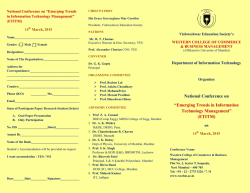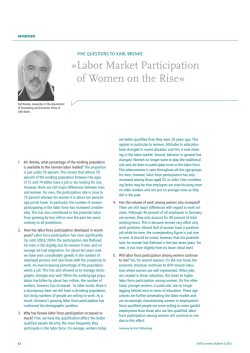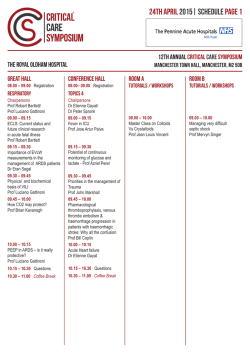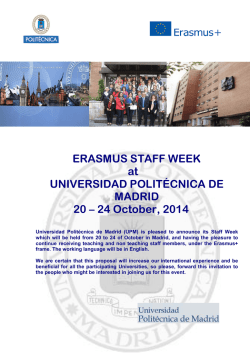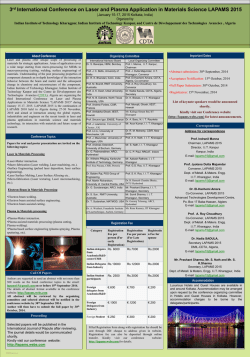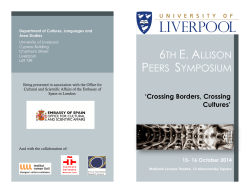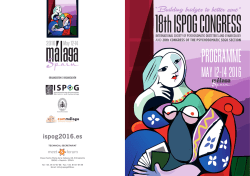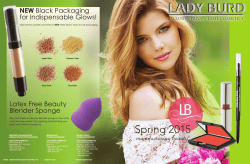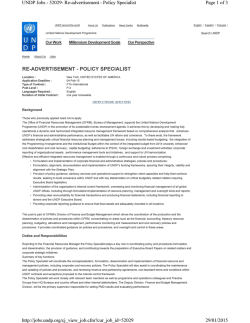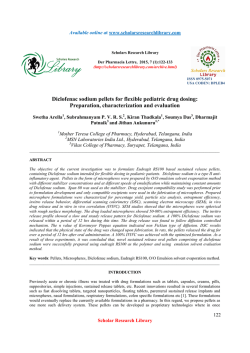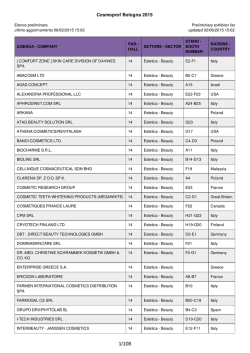
Workshop on Chemical Engineering and Industrial Biology
Workshop on Chemical Engineering and Industrial Biology University Pablo de Olavide (Sevilla, Spain) Ecole de Biologie Industrielle (Cergy- France) Seville, 28-30 January 2015 Wednesday, 28th January (Building 25, Ground floor, “Sala de Grados”) 11:00-11:15, Opening Session 11:15-12:45, Microemulsions in cosmetics applications (Prof. Dr. Vianney Fréville) 12:45-14:15, Substitution of raw materials: context, methodology and examples (Prof. Dr. Vianney Fréville) Thursday, 29th January (Building 25, Ground floor, “Sala de Grados”) 11:00-12:30, Solvents and surfactants derived from renewable raw materials for formulation (Prof. Dr. Vianney Fréville) 12:30-14:00, Heat exchangers (Prof. Dr. Rabah AZOUANI) 18:00-20:00, Poster session (Building 22, 3rd floor) Friday, 30th January (Building 25, Ground floor, “Sala de Grados”) 11:00-12:30, Industrialization (Prof. Dr. Rabah AZOUANI) 12:30-14:00, Risk Assessments (Prof. Dr. Rabah AZOUANI) A certificate of attendance will be issued by the School of Experimental Sciences to students attending at least 4 sessions. For more information: [email protected] Course 1: Microemulsions in cosmetics applications This lecture focuses on the field of microemulsions, particularly in cosmetics applications. The first scientific work on microemulsions was presented in 1943. These systems were defined as dispersed microdroplets in a continuous phase of two non-miscible liquids. Microemulsions were first studied for various industrial applications, e.g., oil recovery, agriculture and chemistry. However, over the last fifteen years, much attention has been paid on their potential applications in cosmetic and pharmaceutical fields. Microemulsions are quaternary systems, transparent, macroscopically monophasic, isotropic and thermodynamically stable. They consist of a hydrophilic phase, a lipophilic phase, a surfactant and a co-surfactant. Their specificity compared to emulsions is based on spontaneous formation, transparency, excellent stability and great solubilizing power. This lecture considers the microemulsions structures, how they can be easily formulated by building pseudo-ternary phase diagrams and their interest in cosmetics applications. This lecture is intended for students with good knowledge of formulation chemistry, particularly in emulsions field. Course 2: Substitution of raw materials: context, methodology and examples This lecture focuses on the substitution of raw materials in formulation. This is a hot topic right now in bio-industries. In this course, the world-wide context around the use of raw materials will be developed as well as the issues and challenges to answer the sustainable development’s needs. An example on how to substitute silicones in cosmetics by using sensorial evaluation will be also presented. This lecture is intended for students with knowledge in chemistry. Course 3: Solvents and surfactants derived from renewable raw materials for formulation This lecture focuses on the development of renewable ingredients obtained from vegetables resources. In this course, the concept of biorefinery will be presented. In the world-wide context of green chemistry, it exploits biomass as a source of renewable raw materials to obtain “eco-friendly” ingredients for formulation. In this way, two kinds of ingredients will be particularly developed, the agrosolvents and agrosurfactants, and some methods to quickly assess their substitution ability will be also presented. This lecture is intended for students with knowledge in chemistry. LecturespropositionSeville‐2015 Heat exchangers The transfer of heat to and from process fluids is an essential part of most industrial processes. This lecture focuses on shell and tube heat exchanger, covering topics of interest to typical process engineers. The basic design procedure and theory will be developed. The key learning objectives is how to specifies and design a Schell and tube heat exchanger. Taking into account the process and fluids properties, two methods are usually used in this approach: - Number of Transfer Units (NTU) Mean Temperature Difference (MTD) The factors influencing the heat exchanger effectiveness will be addressed This lecture is intended for students with knowledge in thermodynamic, Heat and mass transfer Industrialization In this conference, we will discuss the different characteristics and evolution of different industrials fields: pharmaceutical, cosmetic, food and environment. This lectures focuses on the necessary tools for an engineer to define its production unit in light of several constraints: technology, safety and cost. However, we will develop how to prepare and present the process flow-sheet; Block Diagrams, Process flow diagram (PFD) and process instrumentation diagram (PID). A global vision and procedure of the process industrialization will be presented. This lecture is intended for students with knowledge in process and engineering design Risks assessments A prerequisite for every process design is that the safety of people, the environment, and equipment is assured. While it may not be possible or practicable to absolutely prevent every incident, by using appropriate assessment and design tools engineers do strive to strike a consistent balance between safety, technology and cost. This lecture focuses on material hazards, process safety management and hazard analysis with examples of major industrials accidents. Moreover, Qualitative and quantitative methodologies for process hazard will be developed: - Check lists Failure-Mode Effect Analysis (FMEA) Hazard and Operability Studies (HAZOP) This lecture is intended for students with knowledge in process and engineering design RabahAZOUANI‐PhD Page1
© Copyright 2025
